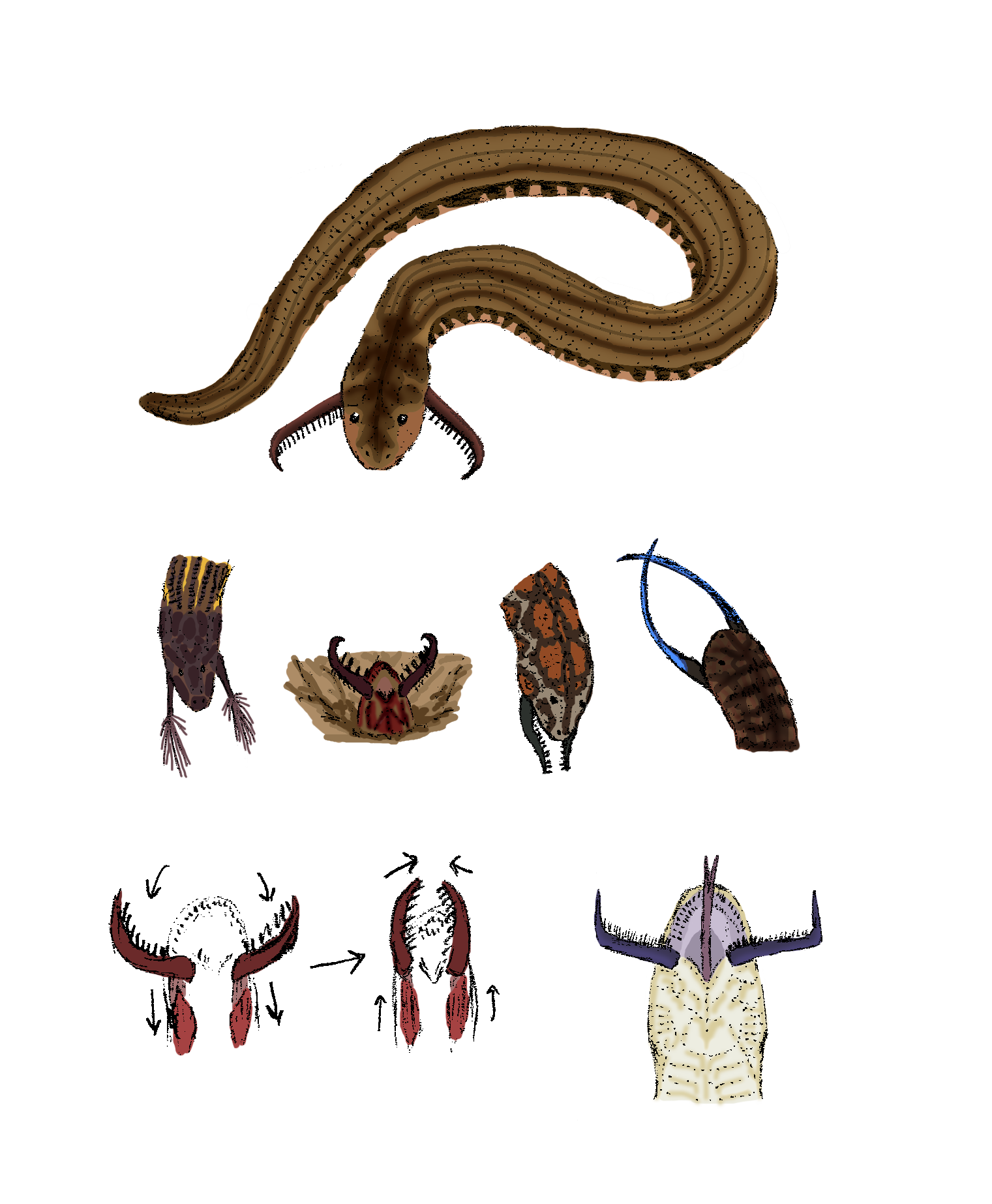HOME | DD
 bicyclefrog — Pincer Snakes
bicyclefrog — Pincer Snakes

#speculativeevolution #speculativebiology #speculativezoology
Published: 2022-12-25 04:26:49 +0000 UTC; Views: 2011; Favourites: 54; Downloads: 3
Redirect to original
Description
Snakes evolved after lizards went underground, lost their legs, and then came back up to the surface. Similarily, history will repeat itself with a group of snakes going underground again and changing drastically, creating the pincer snake family (Solumaxidae). They evolved from a group of Colubrids which became fossorial and greatly shrunk in size. In tight underground tunnels the typical constriction method became useless, especially againt hard-shelled insects which are difficult to swallow whole. Instead, these snakes used their lower jaws to latch onto their prey and rip them apart into more easily consumed pieces.Over time, the ligament that connected the two mandibles was lost, allowing the snake to move the two bones independently and have more control over the process of ripping apart their prey. The snakes would bite off indigestible parts such as the legs and heads of their insect prey and only eat the more edible parts. In their subterranean habitat it was easier to move their jaws horizontally rather than vertically like normal, so the teeth began growing on the side of the bone so the snake would not have to twist their jaws. Eventually, the jaws resembled and worked like the mandibles of the same insects they preyed upon. Still, these snakes were restricted to the underground, barely growing over the length and diameter of a pencil.
The pincer snakes would eventually make their comeback to the surface, with their adaptations to their previous lifestyle giving them an advantage above ground. Their pincers lets them eat a wider variety of prey that other snakes could not, such as carrion and insects. Additionally, they are extremely adept at burrowing and are able to dig their own hibernacula, while other reptiles have to depend on existing ones such as rocky outcrops or burrows of other animals.
At the top is a relatively basal form of pincer snake that can be found in eastern North America. The transitional species are all extinct and while this one is primitive, it already has all the distinct traits of a pincer snake. It still retains its fossorial nature, living under logs and leaf litter in forests. However, as it lives near the surface it can afford to grow larger than its ancestors, reaching a length of two feet.
In the middle are four representatives of this family. From left to right:
- A herbivorous species that lost its toothy pincers. In its place are now several whiskers that are used to feel their way around their dense meadow habitat and inadvertently pollinate plants. With their lower jaws being out of the picture, these snakes now eat by rasping plant material with their upper teeth similarily to a snail. To digest plant material they evolved cecal valves in their gut.
- A widespread subfamily that can be found in deserts and loose soil around the world. They dig themselves into the ground and only leave their jaws sticking out, almost like a tiny bear trap. Others are more elaborate and dig pits like an antlion. Both remain stationary and wait for their prey to unknowingly fall for their traps.
- Some pincer snakes can reach large sizes like the one pictured which can reach up to five feet in length. These snakes are rather fast and are active predators with forward facing eyes. They track down prey using their well developed olfactory senses, wich is also a byproduct of their former fossorial ancestors. They move their jaws independently to saw their prey into smaller pieces and are also capable of doing death rolls.
- The pincers of these snakes have become useless due to their size and are instead used for display purposes. Females evaluate males depending on the size and color of the male's mandibles, which signal that the male is competent at surviving even with his jaws and camouflage at a disadvantage. They are semi-fossorial, living in leaf litter and feeding on earthworms.
There are also several other forms. Some specialized on the rasping behavior, with aquatic species that live in streams and tidepools where they rasp algae off of rocks. Others on land rasp at decaying wood to eat the lichen and fungus growing on it. Back in the water, some have developed their lower jaws into large fans in order to filter feed, while others use their lower jaws as paddles to assist in swimming.
On the lower left it shows how their jaw mechanism works. The muscle flexes and pulls the jaw back, before releasing it with explosive power when relaxed. Pincer snakes are similar to crocodilians in that the muscle is adapted for closing with strength, but not so much opening.
On the lower right is a diagram of their underside. The rasping teeth at the top are able to seen, along with the tongue. Because they are not able to close their mouths anymore, pincer snakes have a flap in their throats that holds closes it while still allowing their tongue to come out and smell.























